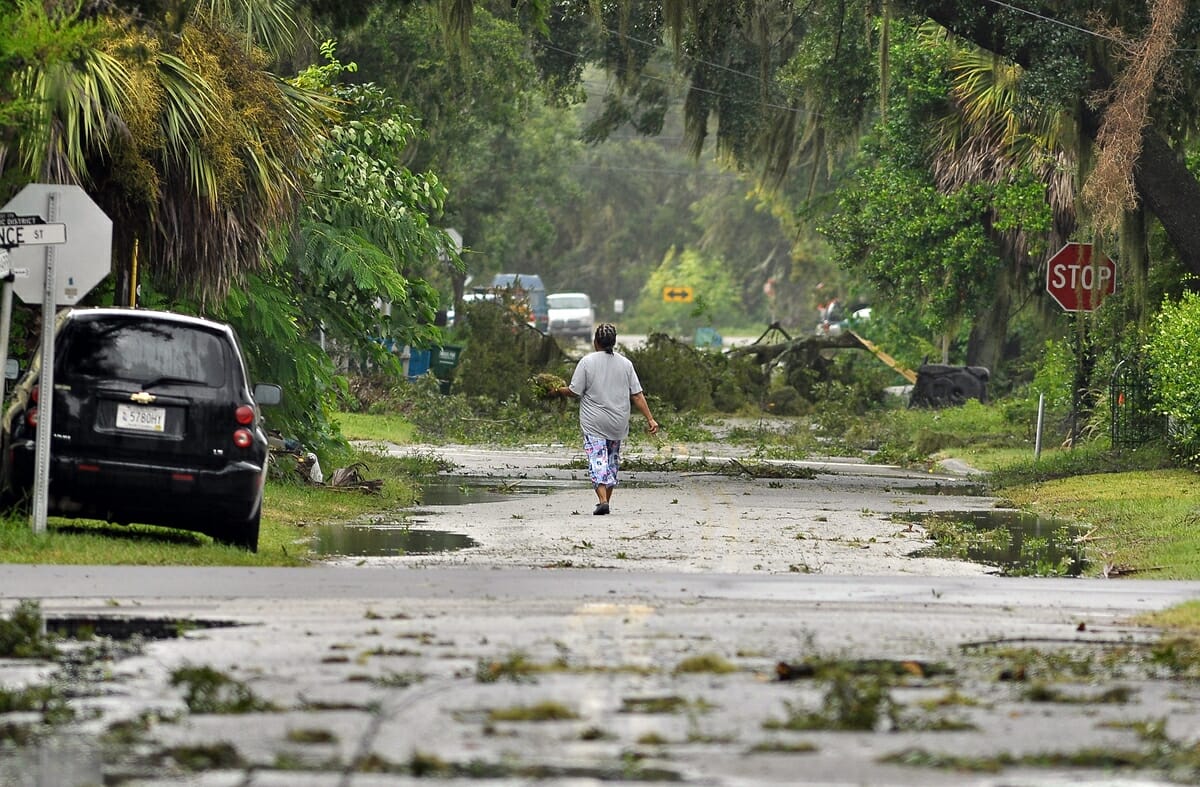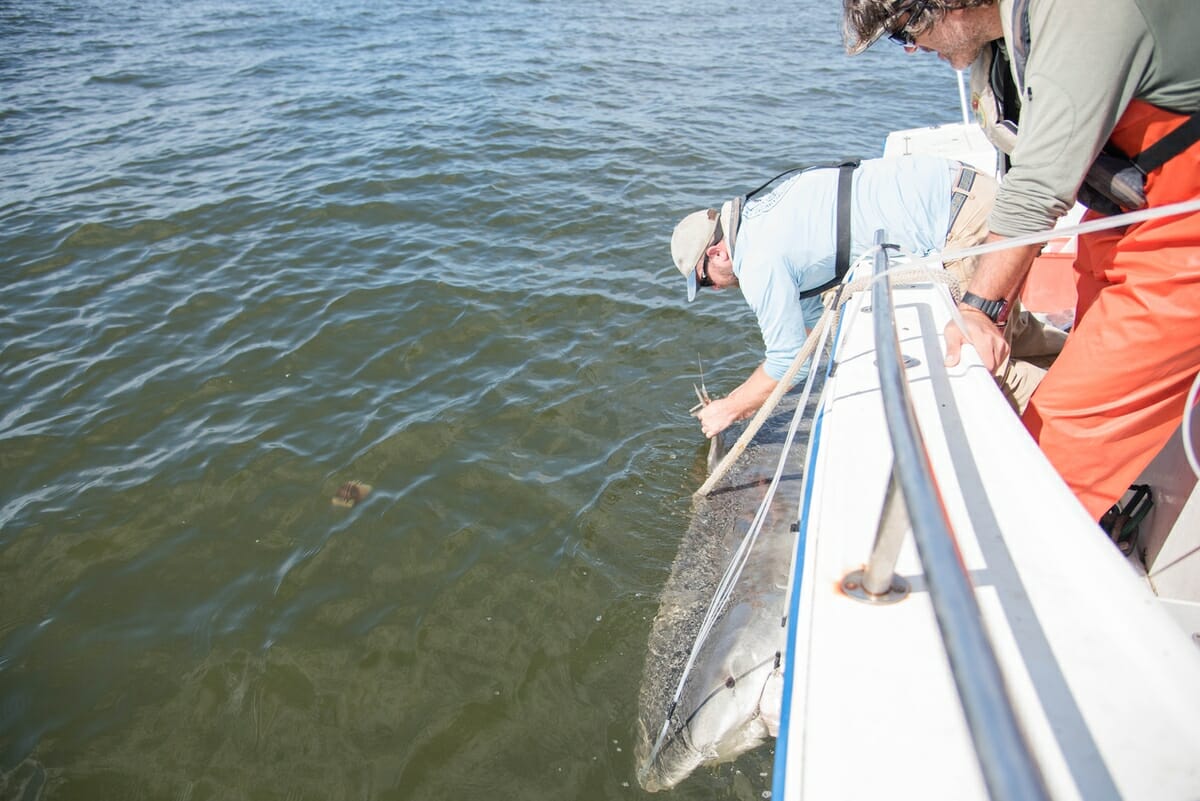Photo above: A woman walks down Harrington Street in Beaufort on Sept. 12. She can’t get too far as a large tree, seen in the background, has blown down and covers the street. Photo by Bob Sofaly.
By Sally Mahan
Hurricane Matthew hit hard in October 2016 and many people didn’t think it could happen again. After all, most hurricanes on the East Coast slide by Beaufort County.
But Irma showed us who the boss was in the 2017 hurricane season, which (thankfully) ended on Nov. 30.
At the height of Irma in Beaufort County — which by then had been downgraded to a tropical storm — on Sept. 11, more than 40,000 homes and businesses were without power.
Almost 100 roads in Northern Beaufort County were closed due to flooding, downed power lines and fallen trees, according to the Beaufort County Sheriff’s Office.
Thousands of people on Fripp, Hunting, Harbor, Daufuskie and Hilton Head islands had been ordered to evacuate.
Hunting Island, which was devastated by Hurricane Matthew, took an especially hard hit, resulting in closing the island to visitors. It is now back up and running, with the Nature Center, lighthouse and north beach area open.
On Thanksgiving Day, 4 miles of trails were reopened, said Park Manager J.W. Weatherford.
He also said the marsh boardwalk will be open by Christmas and they expect the campground to reopen in early 2018.
One sticking point with the campground is the beachfront sites, which were deluged with saltwater that intruded into the electrical and water systems.
“Those sites may not be reopened as they once were, but hopefully they will open soon but they would be more rustic,” said Weatherford.
Looking back
On Sept. 7, forecasts were showing Beaufort County getting a direct hit by a catastrophic hurricane.
Irma started off on Aug. 28 as a tropical wave near the Cape Verde Islands off the coast of West Africa, according to the National Weather Service.
Hurricane Irma made its first landfall in the northeast Caribbean. Two weeks later, Irma became the strongest Atlantic Ocean hurricane on record. Winds peaked at 185 mph, and Irma remained a hurricane for 11 days.
More than 90 percent of the structures on the northeastern Caribbean island of Barbuda were demolished by Irma. She hit Antigua, Puerto Rico, Cuba and other islands.
Then Irma took aim at Florida. As people scrambled to evacuate, I-96 and I-75 became parking lots. Originally forecast to hit hardest on the east side of the state, Irma, by now a Category 4 hurricane, hit hardest on the west side. But she was as big as the state itself, so everyone felt the effects.
In the Florida Keys, more than a quarter of all of the homes were destroyed, according to Florida officials.
There were two deaths in South Carolina, Gov. Henry McMaster said in a press conference on Sept. 12. Neither was from Beaufort County.
As of Nov. 27, more than 10,000 cubic yards of waste/woody debris, 156 cubic yards of metal appliances and 890 cubic yards of construction debris were collected in Northern Beaufort County.
In total, Irma had caused an estimated $30 billion in damages and 49 deaths.
In addition to Irma, three other major hurricanes, Harvey, Maria and Nate, made landfall, affecting more than 25 million people.
Hurricanes Harvey and Irma marked the first time two Atlantic Category 4 hurricanes made landfall in the Continental United States in the same season.
Hurricane Harvey set a new record for the most rainfall from a U.S. tropical cyclone, with more than 50 inches of rain in some areas. The storm resulted in catastrophic flooding in Texas and western Louisiana.
Hurricane Maria devastated the U.S. Virgin Islands and Puerto Rico soon after Hurricane Irma struck their shores. Hurricane Maria was the first Category 4 hurricane to make landfall on the main island of Puerto Rico in 85 years, and the resulting response became the longest sustained air mission of food and water in FEMA history.
Since Harvey made landfall in Texas on Aug. 25, the president has granted 16 Major Disaster declarations and 14 Emergency Declarations, while FEMA has authorized 25 Fire Management Assistance Grant declarations.
So far, more than 4.7 million disaster survivors registered for federal assistance with FEMA – more than all who registered for hurricanes Katrina, Rita, Wilma and Sandy combined.
“This historic hurricane season should serve as a gut check and an opportunity for citizens, businesses, state, local, tribal and federal officials to re-evaluate how we prepare for and respond to any disaster,” said FEMA Administrator Brock Long. “Response and recovery is dependent upon the whole community to be successful. While we continue to support the recovery from these storms, we must also take the opportunity to become better prepared for future disasters.”








